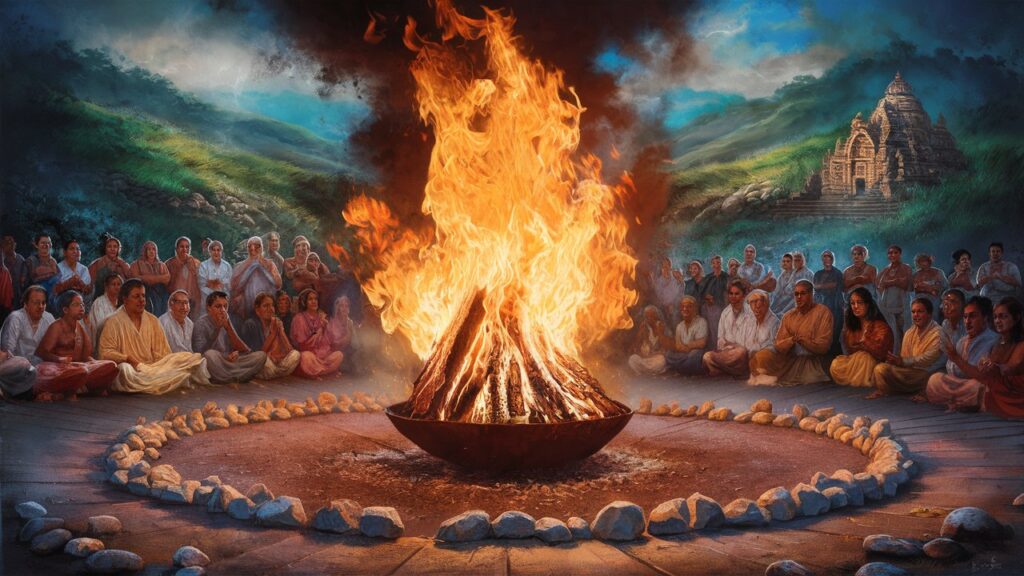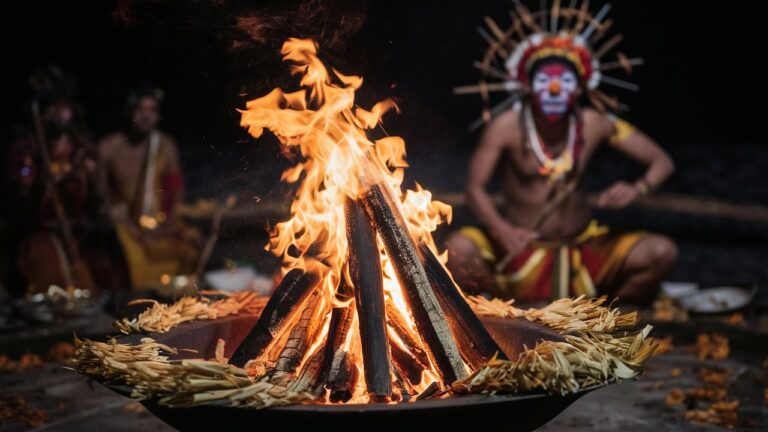Introduction
The ritual of homa (or havan) is an ancient Vedic fire ceremony that has been practiced for millennia in Hindu, Buddhist, and Jain traditions. Rooted in the sacred texts of the Vedas, homa symbolizes the union of humanity with the divine through the medium of fire. It is more than a religious act; it is a holistic practice that integrates spirituality, ecology, and psychology. The flickering flames of the homa fire are believed to purify the environment, invoke blessings from deities, and harmonize cosmic energies. In this article, we delve into the origins, symbolism, and modern relevance of homa, uncovering its profound role as a bridge between the material and spiritual worlds.
1. Origins and Historical Roots of Homa
The homa ritual finds its origins in the Vedic period (circa 1500–500 BCE), where fire (Agni) was revered as a divine messenger connecting humans to the gods. The Rigveda, one of the oldest known scriptures, describes Agni as the “mouth of the gods” and the conduit through which offerings like ghee, grains, and herbs are transported to the celestial realms. Homa evolved as a structured practice to maintain cosmic order (rita) and seek prosperity, health, and protection. Over time, it spread beyond India, influencing rituals in Tibetan Buddhism and Southeast Asian cultures. The continuity of homa across millennia underscores its enduring spiritual and cultural significance.
2. The Spiritual Symbolism of Fire in Homa
Fire in homa represents transformation, destruction of negativity, and illumination of wisdom. Agni, the deity of fire, is both a destroyer and a creator—consuming impurities while generating spiritual energy. The act of offering materials into the flames symbolizes surrendering ego and desires to the divine. The rising smoke carries prayers upward, creating a metaphysical link between Earth and heaven. Additionally, the fire’s heat is seen as a metaphor for inner purification, burning away karmic obstacles and igniting self-awareness. This duality of destruction and renewal makes homa a powerful tool for personal and collective healing.
3. Key Components of a Homa Ceremony
A traditional homa involves several sacred elements:
- The Kund (Fire Altar): A geometrically designed pit, often square or circular, representing the womb of creation.
- Samagri (Offerings): A blend of medicinal herbs, dried fruits, ghee, and wood, chosen for their purifying and aromatic properties.
- Mantras and Chants: Vedic hymns recited to invoke deities and channel energy. Each mantra corresponds to specific intentions, such as health (Ayushya Homa) or wealth (Lakshmi Homa).
- Priest (Ritvik): A trained practitioner who guides the ritual, ensuring adherence to Vedic protocols.
The synergy of these components creates a resonant field of energy, believed to balance the five elements (Pancha Bhoota) and restore harmony.
4. Types of Homa and Their Unique Purposes
Homa rituals vary widely based on intent:
- Agnihotra: A daily sunrise/sunset ceremony to honor solar cycles and purify the atmosphere.
- Rudra Homa: Invokes Lord Shiva for protection and dissolution of suffering.
- Ganapati Homa: Seeks the blessings of Ganesha to remove obstacles.
- Chandi Homa: A potent ritual for defeating negative forces and fostering courage.
Each homa addresses specific human needs—physical, emotional, or spiritual—while aligning with universal rhythms.
5. Scientific Insights into Homa’s Benefits
Modern studies have explored homa’s tangible effects. The combustion of medicinal samagri releases phytochemicals that may purify airborne pathogens, akin to aromatherapy. The rhythmic chanting of mantras generates sound vibrations that reduce stress and enhance mental clarity. Researchers have also noted homa’s potential to neutralize radioactive residues and improve soil fertility in agriculture (Agni Hotra farming). While science continues to unravel its mysteries, homa’s integrative approach to well-being—balancing mind, body, and environment—resonates with holistic health paradigms.
6. Performing a Homa: A Step-by-Step Guide
While traditionally led by priests, simplified homas can be adapted for personal practice:

- Preparation: Cleanse the space and arrange the kund. Light the fire using ghee-soaked wood.
- Invocation: Chant Agni mantras to kindle divine energy.
- Offerings: Feed the fire with samagri while focusing on your intention.
- Meditation: Absorb the fire’s energy, visualizing negativity dissolving into the flames.
- Closure: Express gratitude and disperse the ashes as a sacred offering.
This structured yet flexible process allows homa to remain accessible in contemporary settings.
7. Homa in the Modern World: Relevance and Adaptations
Today, homa transcends religious boundaries, embraced by wellness enthusiasts and environmentalists alike. Urban homas incorporate eco-friendly materials, while virtual ceremonies connect global participants. Yoga studios and healing centers use homa for energy cleansing, and its principles align with sustainability movements—emphasizing reverence for nature. In a fragmented world, homa offers a unifying space for collective intention and ecological mindfulness.
Conclusion
Homa is not merely a relic of antiquity but a living tradition that adapts to humanity’s evolving needs. Its flames remind us of the impermanence of material life and the eternal light of consciousness. By participating in homa, we honor ancient wisdom while contributing to a harmonious future. Whether seeking solace, healing, or connection, this sacred fire ritual invites us to transform ourselves and the world—one offering at a time.
Frequently Asked Questions (FAQs)
Q1: Can anyone perform a homa, or does it require a priest?
While priests ensure Vedic precision, simplified homas can be performed by individuals with sincere intent. Guidance from knowledgeable practitioners is recommended for rituals involving complex mantras.
Q2: What is the significance of homa ashes (vibhuti)?
Ashes are considered sacred and believed to carry protective energy. They’re often applied to the forehead or used in blessings.
Q3: How does homa differ from other fire rituals like yajna?
Homa is a subset of yajna (sacrifice). While yajna can involve elaborate offerings, homa specifically centers on fire as the medium.
Q4: Are there environmental concerns with homa?
Traditional homa uses minimal natural materials. Modern adaptations prioritize sustainability, using organic samagri and avoiding synthetic substances.
Q5: Can homa improve mental health?
Yes. The combination of meditation, mantra chanting, and fire-gazing reduces anxiety and enhances focus, akin to mindfulness practices.
Q6: Is scientific evidence supporting homa’s benefits credible?
Preliminary studies show promise, though more research is needed. Anecdotal accounts and ancient texts highlight its enduring efficacy.
This comprehensive exploration illuminates homa’s timeless power—an alchemy of fire, faith, and transformation.
